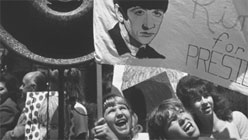In April 1964, a nomadic, twenty-three-year-old Arthur Tress moved to San Francisco, after previous travels in Mexico, to visit his sister and continue his art practice in photography and painting. Shortly after his arrival, he wrote to his father and brother — his sources of income at the time — with this observation: “The city itself and especially Oakland is very clean and monotonous.”1 Despite the turbulent political and cultural climate of San Francisco at this time — civil rights activists protesting on Auto Row in April, and the Beatles and the Republican National Convention coming to town in July and August, respectively — similar sentiments were separately conveyed by Hunter S. Thompson who, when bemoaning the flight of the beatniks to New York City, wrote, “Life is more peaceful in San Francisco, but infinitely duller.”2
During the short time Tress spent photographing San Francisco in the spring and summer of 1964, he amassed more than nine hundred negatives, from which curator James A. Ganz has selected seventy-one for the exhibition Arthur Tress: San Francisco 1964. The selection focuses on San Franciscans in an environment dominated by political rallies, signage (both commercial and political), and architecture. As emphasized by the exhibit’s title, these images present San Francisco and its people in a specific time and place: a baby sits in a stroller in Union Square with a “Goldwater For President” button pinned to her bonnet; a business man at City Hall clutches a daily paper with the headline, “Murder in the Park”; a woman rests in a self-service laundromat, the walls of which are emblazoned with classic ’60s typefaces. But the ways in which Tress plays off of and pairs these details make these photographs historically insightful while uniquely his own.

Untitled (Union Square), 1964; Courtesy of de Young Museum, San Francisco.
Tress’s and Thompson’s observations about a tedious San Francisco resonate most in the faces and postures of the people in these photographs, the vast majority of which either look devastatingly bored or severely pensive. The aforementioned lady in the laundromat, for example, appears not to be waiting for her wash but for initiative; the businessman at City Hall and the Goldwater baby share the same look of deep contemplation, a distant beyond-the-frame stare that is disturbing in its severity. Indeed, very few of Tress’s subjects — aside from clowns with painted smiles and politicians’ grinning heads on campaign posters — are smiling. Ennui seems to be a constant. As a respite, Tress injects humor into many of his compositions, using repetition, perspective shifts, and juxtapositions to help lighten the mood. In one hilarious photo, two teenage girls at a Beatles fan club rally stand beneath their homemade “Ringo for President” sign, their faces ecstatically wrenched in contrast to the hand-drawn image of Ringo, who looks hopelessly depressed.
Such contextual playfulness — a quality of Tress’s work throughout his career — pushes these otherwise mundane scenes into a new light through combinatorial shifts of subtle details. In one photo, due to a flattened perspective, a young girl sitting on a window ledge appears to be resting her dangling feet on a businessman’s pompadour. In another, Tress captures the lovely repetition of the word Cadillac on a sun-glared storefront window, in front of which stands an African American man in a suit, casting a glare of his own. Tress’s attention to what the surrounding environment suggests helps elide any overwrought socio-political interpretations that these images’ historic context might imply. There’s also the pairing and juxtaposition of people with various objects (mannequin head, gas pump, tricycle) and commercial signage that pushes one’s attention to the surface, so that the shared stoic stares of a mannequin and a woman lose their emotive weight in the face of the formal features that surround them. Children provide another reprieve from the tension found in these scenes. Tress’s photos break the monotony and provide a fuller view into the lives of everyday San Franciscans: a panorama that takes in the banal with the beautiful and the dull with the remarkable.


